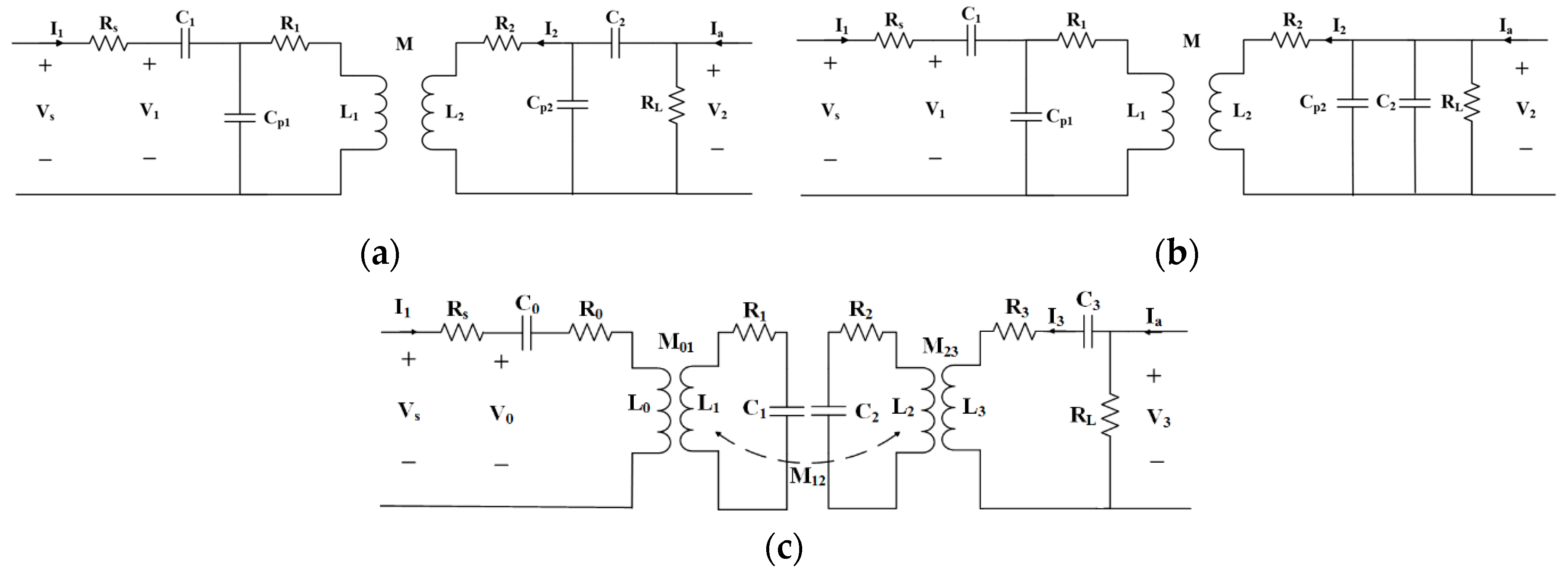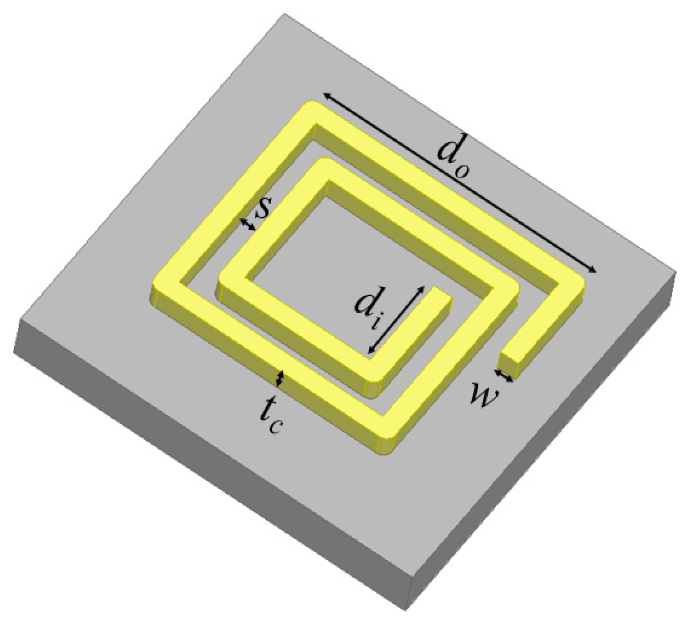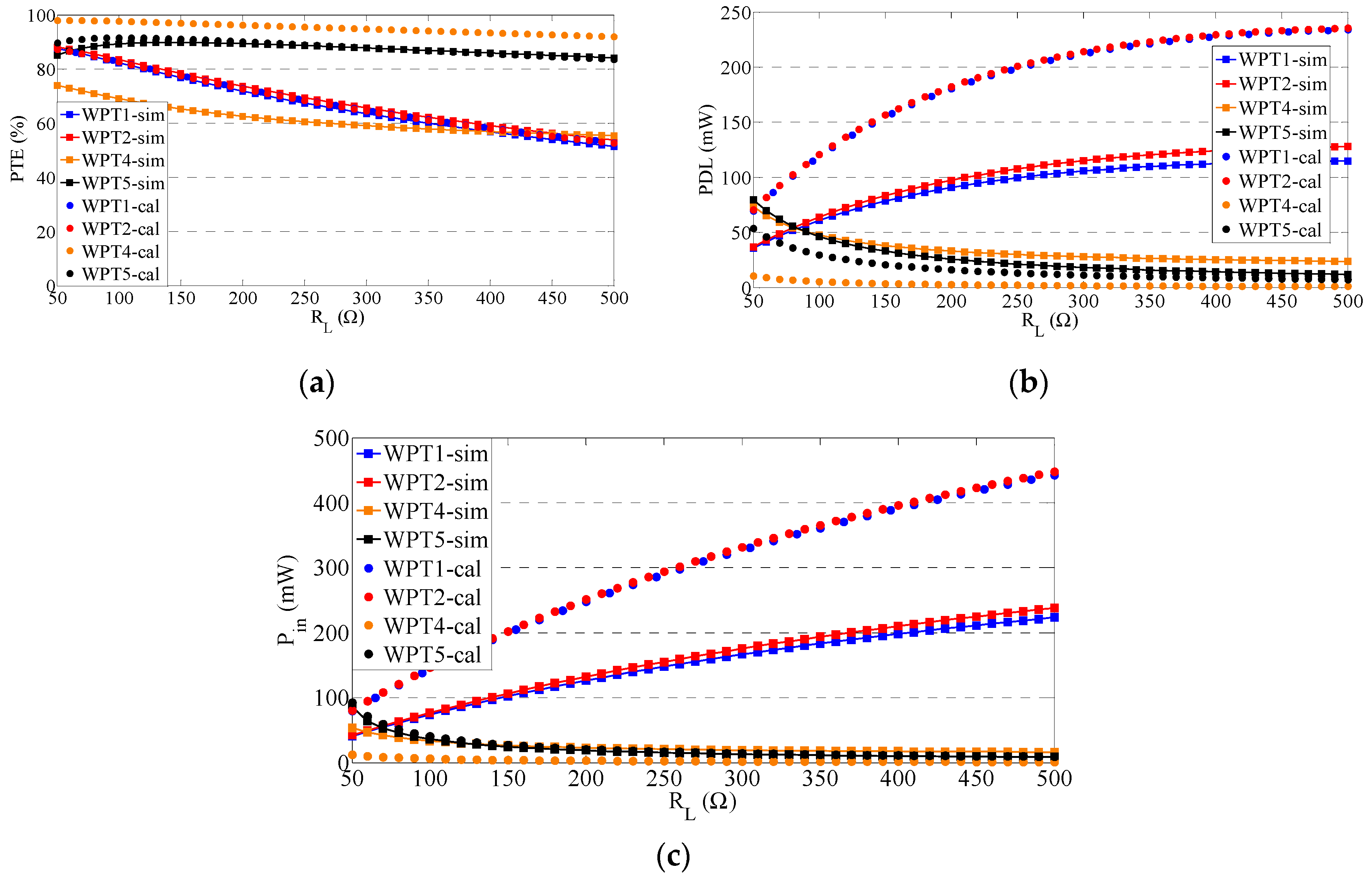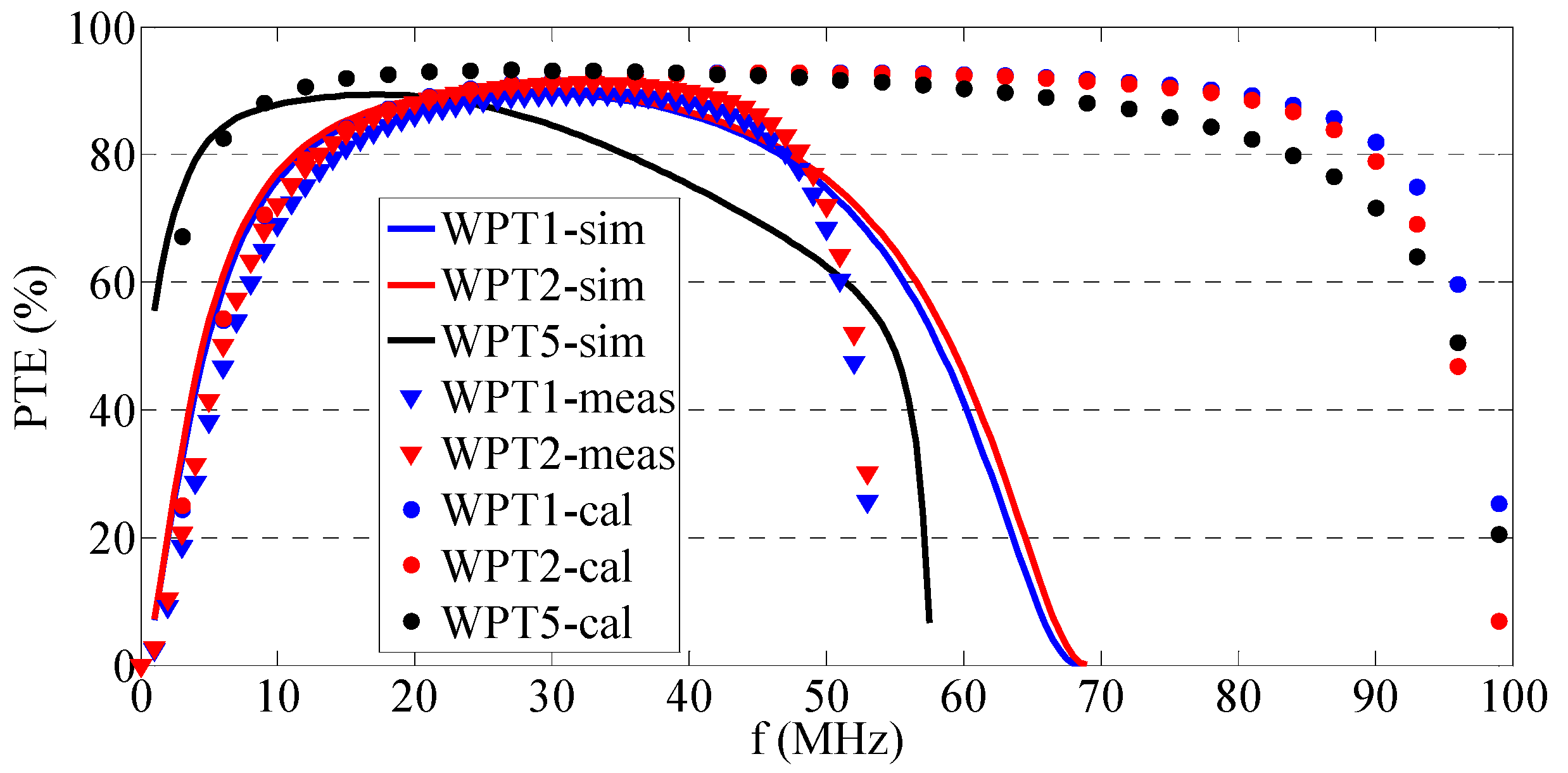A Systematic Methodology for Optimal Design of Wireless Power Transfer System Using Genetic Algorithm
Abstract
:1. Introduction
2. Inductive Link Model
3. Design Procedure
- Define the Fitness Function: The fitness function, an objective function, which evaluates the quality of the chromosome as a solution to a particular problem, will be optimized. For the design of a WPT link, the PTE, voltage gain, PDL or combination of these figure of merits can be considered as the fitness function in GA.
- Define Design Parameters: In the next step, the design parameters (i.e., the geometrical parameters that their values are determined by the proposed algorithm) and constants are defined according to the application and coil types. For example, the parameters , , , , and operating frequency () can be considered as the design parameters of the PSC.
- Define Constraints: To obtain a feasible solution for the fitness function, we should take into account the major design constraints imposed by regulations, application and the PSC fabrication technology. For this purpose, it is necessary to select an acceptable range for the design parameters. The lower and upper bounds of the variables should be selected such that the implementation of the PSC can be realistically achieved and an acceptable HFSS simulation is obtained for verifying the values suggested by theoretical calculations. To achieve the maximum magnetic field strength, the outer diameter of the Tx coil () should satisfy the constraint [11]. Increasing the size of the receiver coil enhances the PTE, however, there is a limitation on the coil size in IMDs. Another important constraint is the constraint on the SRF, which is a key factor in determining the power carrier frequency. Reducing the SRF limits the power carrier frequency. The inductance of the coil and its parasite capacitance determine the SRF ().
- Generate an Initial Random Population of Chromosomes: Before generating the population, the type of encoding should be defined. In the current study, the real encoding was used to encode the chromosomes.
- Calculate the Fitness of Each Chromosome: The fitness score of each chromosome is calculated by the fitness function and then converted to a value within a range that is suitable for the selection function by the scaling function.
- Selection: The selection function chooses chromosomes for recombination on the basis of fitness. Those with higher fitness should have a greater chance of selection than those with lower fitness.
- Reproduction: In this step, a new population with new chromosomes is created from the above selected individuals by using the crossover (recombination) and mutation operations.
- Evolution: After recombination, the resultant chromosomes are passed into the successor population. The processes of selection and recombination are then iterated until a complete successor population is produced. At that point, the successor population becomes a new source population (i.e., the next generation).
- Repeat from step 5 until the appropriate stopping criteria are met, for example, an upper limit on the number of generations is reached.
4. Design Examples
5. Simulation Results
5.1. Effects of Load Resistance
5.2. Effects of Source Resistance
5.3. Effects on Reflected Impedance
5.4. Effects of Distance
6. Measurement Results
7. Comparison
8. Conclusions
Author Contributions
Funding
Conflicts of Interest
Appendix A
References
- Bashirullah, R. Wireless implants. IEEE Microw. Mag. 2010, 11, S14–S23. [Google Scholar] [CrossRef]
- Fitzpatrick, D. Implantable Electronic Medical Devices, 1st ed.; Elsevier: Amsterdam, The Netherlands, 2014. [Google Scholar]
- Hui, S.Y.; Zhong, W.; Lee, C.K. A critical review of recent progress in mid-range wireless power transfer. IEEE Trans. Power Electron. 2014, 29, 4500–4511. [Google Scholar] [CrossRef] [Green Version]
- Kiani, M.; Ghovanloo, M. A figure-of-merit for designing high-performance inductive power transmission links. IEEE Trans. Ind. Electron. 2013, 60, 5292–5305. [Google Scholar] [CrossRef] [PubMed]
- Moon, S.C.; Moon, G.W. Wireless power transfer system with an asymmetric four-coil resonator for electric vehicle battery chargers. IEEE Trans. Power Electron. 2016, 31, 6844–6854. [Google Scholar] [CrossRef]
- Yin, J.; Lin, D.; Parisini, T.; Hui, S.Y. Front-end monitoring of the mutual inductance and load resistance in a series–series compensated wireless power transfer system. IEEE Trans. Power Electron. 2016, 31, 7339–7352. [Google Scholar] [CrossRef]
- Iguchi, S.; Yeon, P.; Fuketa, H.; Ishida, K.; Sakurai, T.; Takamiya, M. Wireless power transfer with zero-phase-difference capacitance control. IEEE Trans. Circuits Syst. I Reg. Pap. 2015, 62, 938–947. [Google Scholar] [CrossRef]
- Li, Y.; Hu, J.; Chen, F.; Li, Z.; He, Z.; Mai, R. Dual-phase-shift control scheme with current-stress and efficiency optimization for wireless power transfer systems. IEEE Trans. Circuits Syst. I Reg. Pap. 2018, 65, 3110–3121. [Google Scholar] [CrossRef]
- IEEE Standard for the Safety Levels with Respect to Human Exposure to Radiofrequency Electromagnetic Fields, 3 KHz–300 GHz; IEEE Std. C95.1-2005 (Revision of IEEE Std. C95.1-1991); IEEE: New York, NY, USA, 2006; pp. 1–238. [CrossRef]
- Kiani, M.; Jow, U.; Ghovanloo, M. Design and optimization of a 3-coil inductive link for efficient wireless power transmission. IEEE Trans. Biomed. Circuits Syst. 2011, 5, 579–591. [Google Scholar] [CrossRef] [PubMed] [Green Version]
- Jow, U.; Ghovanloo, M. Design and optimization of printed spiral coils for efficient transcutaneous inductive power transmission. IEEE Trans. Biomed. Circuits Syst. 2007, 1, 193–202. [Google Scholar] [CrossRef] [PubMed]
- Jow, U.; Ghovanloo, M. Modeling and optimization of printed spiral coils in air, saline, and muscle tissue environments. IEEE Trans. Biomed. Circuits Syst. 2009, 3, 339–347. [Google Scholar] [CrossRef] [Green Version]
- RamRakhyani, A.K.; Mirabbasi, S.; Chiao, M. Design and optimization of resonance-based efficient wireless power delivery systems for biomedical implants. IEEE Trans. Biomed. Circuits Syst. 2011, 5, 48–63. [Google Scholar] [CrossRef] [PubMed]
- Floudas, C.A.; Pardalos, P.M. Encyclopedia of Optimization, 2nd ed.; Springer: New York, NY, USA, 2001. [Google Scholar]
- Han, J.; Kim, Y.D.; Myung, N.H. Efficient performance optimisation of wireless power transmission using genetic algorithm. Electron. Lett. 2014, 50, 462–464. [Google Scholar] [CrossRef]
- Wang, G.; Li, X.; Wang, M.; Yuan, H.; Xu, W. Optimization of a dual band wireless power and data telemetry system using genetic algorithm. IEEE Des. Test. 2016, 35, 54–65. [Google Scholar] [CrossRef]
- Mc Call, J. Genetic algorithms for modelling and optimization. Comput. Appl. Math. 2005, 184, 205–222. [Google Scholar] [CrossRef]
- Mirbozorgi, S.A.; Bahrami, H.R.; Sawan, M.; Gosselin, B. A smart multicoil inductively-coupled array for wireless power transmission. IEEE Trans. Ind. Electron. 2014, 61, 6061–6070. [Google Scholar] [CrossRef]
- RamRakhyani, A.K.; Lazzi, G. On the design of efficient multi-coil telemetry system for biomedical implants. IEEE Trans. Biomed. Circuits Syst. 2013, 7, 11–23. [Google Scholar] [CrossRef] [PubMed]








| Problem Setup | Parameter | Series Connection Load | Parallel Connection Load | |||
|---|---|---|---|---|---|---|
| WPT1 | WPT2 | WPT3 | WPT4 | WPT5 | ||
| Design parameters | Tx coil inner diameter (mm) | |||||
| Rx coil inner diameter (mm) | ||||||
| Width of tracks (µm) | ||||||
| Space between tracks (µm) | ||||||
| Number of turns | ||||||
| Metal thickness (µm) | ||||||
| Constraints | Rx coil parasitic resistance (Ω) | - | - | - | - | |
| Tx coil outer diameter (mm) | ||||||
| Rx coil outer diameter (mm) | ||||||
| Self-Resonance-Frequency (MHz) | ||||||
| Distance between coils (mm) | ||||||
| Power Carrier Frequency (MHz) | ||||||
| Source resistance (Ω) | ||||||
| Load resistance (Ω) | ||||||
| Coil | Parameter | WPT1 | WPT2 | WPT3 | WPT4 | WPT5 | WPT6 | WPT7 |
|---|---|---|---|---|---|---|---|---|
| Driver Coil | n0 | - | - | - | - | - | - | 14 |
| w0 (µm) | - | - | - | - | - | - | 439 | |
| s0 (µm) | - | - | - | - | - | - | 427 | |
| di0 (mm) | - | - | - | - | - | - | 4 | |
| tc0 (μm) | - | - | - | - | - | - | 35 | |
| L0 (μH) | - | - | - | - | - | - | 3.08 | |
| R0 (Ω) | - | - | - | - | - | - | 2.08 | |
| Cp0 (pF) | - | - | - | - | - | - | 0.77 | |
| do0 (mm) | - | - | - | - | - | - | 28.25 | |
| SRF0 (MHz) | - | - | - | - | - | - | 103.41 | |
| Q1 | - | - | - | - | - | - | 100.01 | |
| Tx Coil | n1 | 11 | 11 | 8 | 8 | 11 | 8 | 6 |
| w1 (µm) | 1490 | 1398 | 1613 | 2561 | 1979 | 1280 | 2123 | |
| s1 (µm) | 282 | 374 | 262 | 349 | 603 | 282 | 357 | |
| di1 (mm) | 1 | 1 | 10 | 11 | 2 | 15 | 30 | |
| tc1 (μm) | 35 | 48 | 46 | 35 | 35 | 35 | 35 | |
| L1 (μH) | 2.11 | 2.11 | 1.78 | 2.27 | 3.16 | 2.28 | 2.46 | |
| R1 (Ω) | 0.56 | 0.55 | 0.44 | 0.59 | 0.63 | 0.68 | 0.5 | |
| Cp1 (pF) | 1.17 | 1.2 | 1.42 | 1.11 | 0.8 | 1.12 | 1.02 | |
| do1 (mm) | 39.98 | 39.98 | 40 | 57.56 | 58.8 | 40 | 59.76 | |
| SRF1 (MHz) | 101.27 | 100.10 | 100.02 | 100 | 100.01 | 100.14 | 100.34 | |
| Q1 | 169.77 | 170.79 | 161.89 | 212.11 | 233.8 | 162.09 | 410.95 | |
| Rx Coil | n2 | 11 | 13 | 20 | 2 | 3 | 4 | 4 |
| w2 (µm) | 264 | 283 | 239 | 4000 | 901 | 546 | 550 | |
| s2 (µm) | 236 | 255 | 236 | 200 | 432 | 150 | 186 | |
| di2 (mm) | 9 | 6 | 1 | 1 | 12 | 14 | 14 | |
| tc2 (μm) | 35 | 35 | 18 | 35 | 35 | 35 | 35 | |
| L2 (μH) | 2.5 | 2.6 | 3.68 | 0.03 | 0.25 | 0.55 | 0.54 | |
| R2 (Ω) | 2.52 | 2.46 | 4.87 | 0.002 | 0.2 | 0.5 | 0.5 | |
| Cp2 (pF) | 0.98 | 0.97 | 0.69 | 0.079 | 0.11 | 0.54 | 0.44 | |
| do2 (mm) | 20 | 19.99 | 20 | 17.8 | 20 | 19.57 | 19.89 | |
| SRF2 (MHz) | 101.52 | 100.16 | 100.08 | 3271.1 | 948.53 | 291.4 | 325.18 | |
| Q2 | 84.49 | 89.89 | 64.36 | 1899.9 | 105.94 | 93.18 | 92.46 | |
| Load Coil | n3 | - | - | - | - | - | 9 | 14 |
| w3 (µm) | - | - | - | - | - | 200 | 198 | |
| s3 (µm) | - | - | - | - | - | 150 | 168 | |
| di3 (mm) | - | - | - | - | - | 7 | 3 | |
| tc3 (μm) | - | - | - | - | - | 35 | 35 | |
| L3 (μH) | - | - | - | - | - | 1.29 | 1.72 | |
| R3 (Ω) | - | - | - | - | - | 1.9 | 2.35 | |
| Cp3 (pF) | - | - | - | - | - | 0.87 | 1 | |
| do3 (mm) | - | - | - | - | - | 13.3 | 13.25 | |
| SRF3 (MHz) | - | - | - | - | - | 150.31 | 121.49 | |
| Q3L | - | - | - | - | - | 1.08 | 1.43 | |
| Results | k01 | - | - | - | - | - | - | 0.26 |
| k12 | 0.12 | 0.12 | 0.12 | 0.15 | 0.14 | 0.13 | 0.11 | |
| k23 | - | - | - | - | - | 0.37 | 0.33 | |
| PTE (%) | 82.65 | 82.58 | 83.3 | 97.64 | 91.45 | 86.32 | 87.46 |
| Coil | Parameter | WPT1 | WPT2 | WPT3 | WPT4 | WPT5 | WPT6 | WPT7 |
|---|---|---|---|---|---|---|---|---|
| Driver Coil | L0 (μH) | - | - | - | - | - | - | 3.1 |
| R0 (Ω) | - | - | - | - | - | - | 2.05 | |
| Cp0 (pF) | - | - | - | - | - | - | 1.07 | |
| SRF0 (MHz) | - | - | - | - | - | - | 87.3 | |
| Q0 | - | - | - | - | - | - | 103.28 | |
| Tx Coil | L1 (μH) | 2.07 | 2.11 | 1.75 | 2.19 | 3.25 | 2.26 | 2.51 |
| R1 (Ω) | 1.67 | 1.43 | 1.13 | 1.25 | 1.56 | 1.44 | 1.13 | |
| Cp1 (pF) | 2.49 | 2.4 | 2.58 | 2.81 | 2.29 | 2.03 | 3.06 | |
| SRF1 (MHz) | 70.06 | 70.65 | 74.86 | 64.2 | 58.36 | 74.3 | 57.4 | |
| Q1 | 81.52 | 92.94 | 91.68 | 106.94 | 134.13 | 98.94 | 188.65 | |
| Rx Coil | L2 (μH) | 2.59 | 2.69 | 1 - | 0.04 | 0.27 | 0.33 | 0.56 |
| R2 (Ω) | 2.08 | 2.14 | 106.87 | 0.05 | 0.21 | 0.44 | 0.56 | |
| Cp2 (pF) | 1.7 | 1.57 | - | 0.14 | 1.96 | 1.97 | 2.11 | |
| SRF2 (MHz) | 75.82 | 77.43 | - | 2142 | 219 | 198.7 | 146 | |
| Q2 | 106.02 | 107.28 | - | 59.74 | 110 | 63.13 | 85.24 | |
| Load Coil | L3 (μH) | - | - | - | - | - | 1.28 | 1.73 |
| R3 (Ω) | - | - | - | - | - | 1.58 | 1.79 | |
| Cp3 (pF) | - | - | - | - | - | 0.86 | 0.7 | |
| SRF3 (MHz) | - | - | - | - | - | 151.3 | 144.9 | |
| Q3L | - | - | - | - | - | 1.07 | 1.45 | |
| Results | PTE (%) | 82.26 | 83.42 | - | 69.05 | 89.22 | 83.22 | 85.99 |
| Coil | Symbol | WPT1 | WPT2 |
|---|---|---|---|
| Tx Coil | L1 (μH) | 2.29 | 2.37 |
| R1 (Ω) | 2.78 | 2.89 | |
| Cp1 (pF) | 3.83 | 3.69 | |
| SRF1 (MHz) | 53.74 | 53.74 | |
| Rx Coil | L2 (μH) | 2.83 | 2.96 |
| R2 (Ω) | 3.29 | 2.31 | |
| Cp2 (pF) | 2.61 | 2.48 | |
| SRF2 (MHz) | 58.61 | 58.71 | |
| Results | PTE (%) | 80.32 | 82.72 |
| PDL (mW) | 155.24 | 173.89 |
| Ref. | Type of Links/Coils | Frequency (MHz) | Diameter of Tx Coil (mm) | Diameter of Rx Coil (mm) | Distance between to Coils (mm) | Source Resistance (Ω) | Load Resistance (Ω) | Power Transfer Efficiency (%) | Power Delivered to the Load (mW) |
|---|---|---|---|---|---|---|---|---|---|
| [4] | 2-coil/Wire wound | 13.56 | 125 | 40 | 100 | 0.5 | 5 | 28.4 | 79 |
| 3-coil/Wire wound | 117 | 36.1 | 92 | ||||||
| 4-coil/Wire wound | 150 | 42.8 | 114.4 | ||||||
| 2-coil/Wire wound | 0.145 | 750 | 500 | 200 | 0.5 | 20 | 60.8 | 176.4 | |
| 3-coil/Wire wound | 620 | 69.3 | 169.3 | ||||||
| 4-coil/Wire wound | 343 | 66.7 | 163 | ||||||
| [11] | 2-coil/Printed spiral | 5 | 40 | 20 | 10 | Not considered | 500 | 78 | Not reported |
| [12] | 2-coil/Printed spiral | 13.56 | 38 | 10 | 10 | Not considered | 500 | 72.22 | Not reported |
| [10] | 2-coil/Printed spiral and wire wound | 13.56 | 168 | 40 | 120 | 0.1 | 100 | 15 | 170 |
| 3-coil/Printed spiral and wire wound | 37 | 260 | |||||||
| 4-coil/Printed spiral and wire wound | 35 | 4.4 | |||||||
| [13] | 4-coil/Multi strands Litz wire | 0.7 | 64 | 22 | 20 | 5.6 | 100 | 82 | Not reported |
| [16] | 4-coil/Printed spiral (2 coils for power transfer) | 1 | 36.4 | 13.67 | 10 | Not mentioned | Not mentioned | 69.8 | Not reported |
| [18] | 3-coil/Printed array | 0.2 | 300 × 300 | 54 | <10 | 1 | 10 | 83.3 | 3870 |
| [19] | 2-coil/Multi strands Litz wire | 3 | 40 | 15 | 12 | 5.1 | 100 | 35 | Not reported |
| 3-coil/Multi strands Litz wire | 36 | 12 | 5.1 | 100 | 65 | Not reported | |||
| This work | 2-coil/Printed spiral | 13.56 | 40 | 20 | 10 | 0.5 | 100 | 82.72 | 173.89 |
© 2020 by the authors. Licensee MDPI, Basel, Switzerland. This article is an open access article distributed under the terms and conditions of the Creative Commons Attribution (CC BY) license (http://creativecommons.org/licenses/by/4.0/).
Share and Cite
Bagheri, A.; Erfanian, A.; Abrishamifar, A. A Systematic Methodology for Optimal Design of Wireless Power Transfer System Using Genetic Algorithm. Energies 2020, 13, 383. https://doi.org/10.3390/en13020383
Bagheri A, Erfanian A, Abrishamifar A. A Systematic Methodology for Optimal Design of Wireless Power Transfer System Using Genetic Algorithm. Energies. 2020; 13(2):383. https://doi.org/10.3390/en13020383
Chicago/Turabian StyleBagheri, Anahita, Abbas Erfanian, and Adib Abrishamifar. 2020. "A Systematic Methodology for Optimal Design of Wireless Power Transfer System Using Genetic Algorithm" Energies 13, no. 2: 383. https://doi.org/10.3390/en13020383





